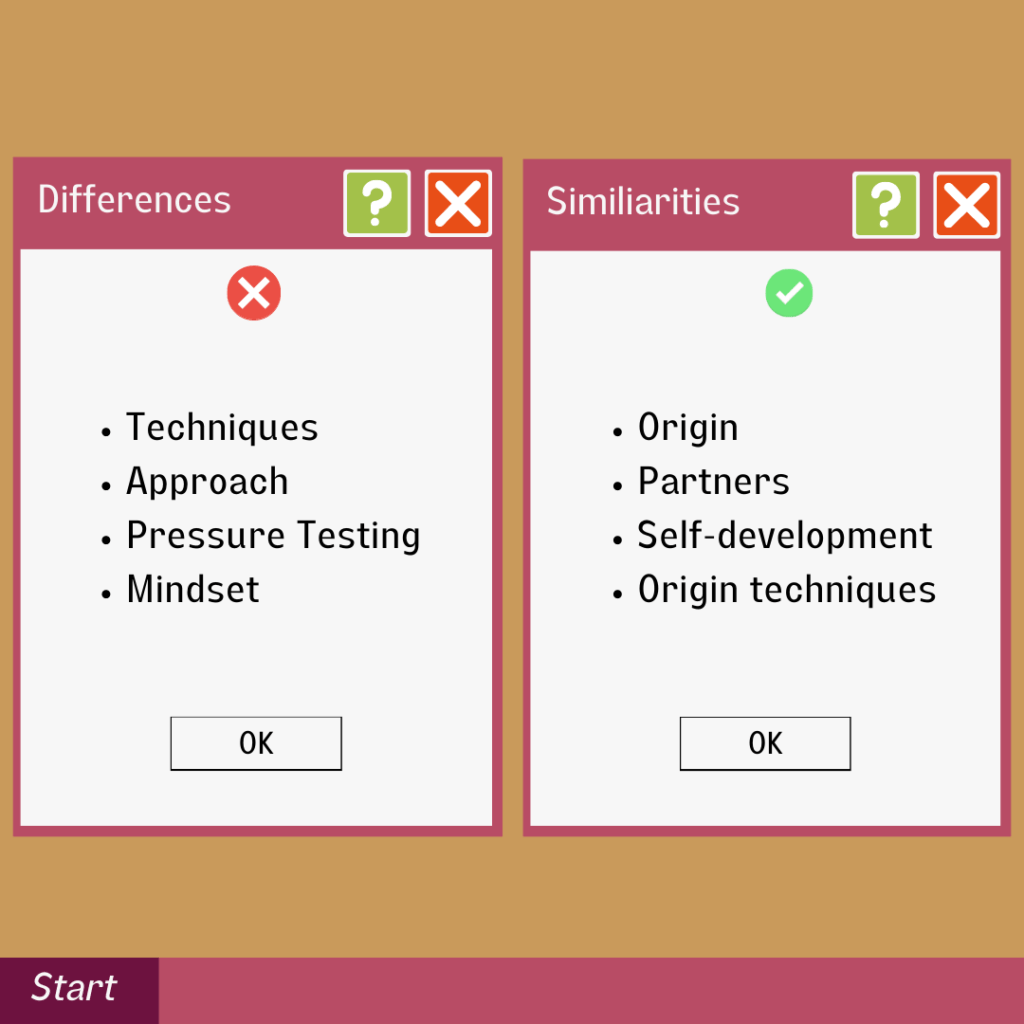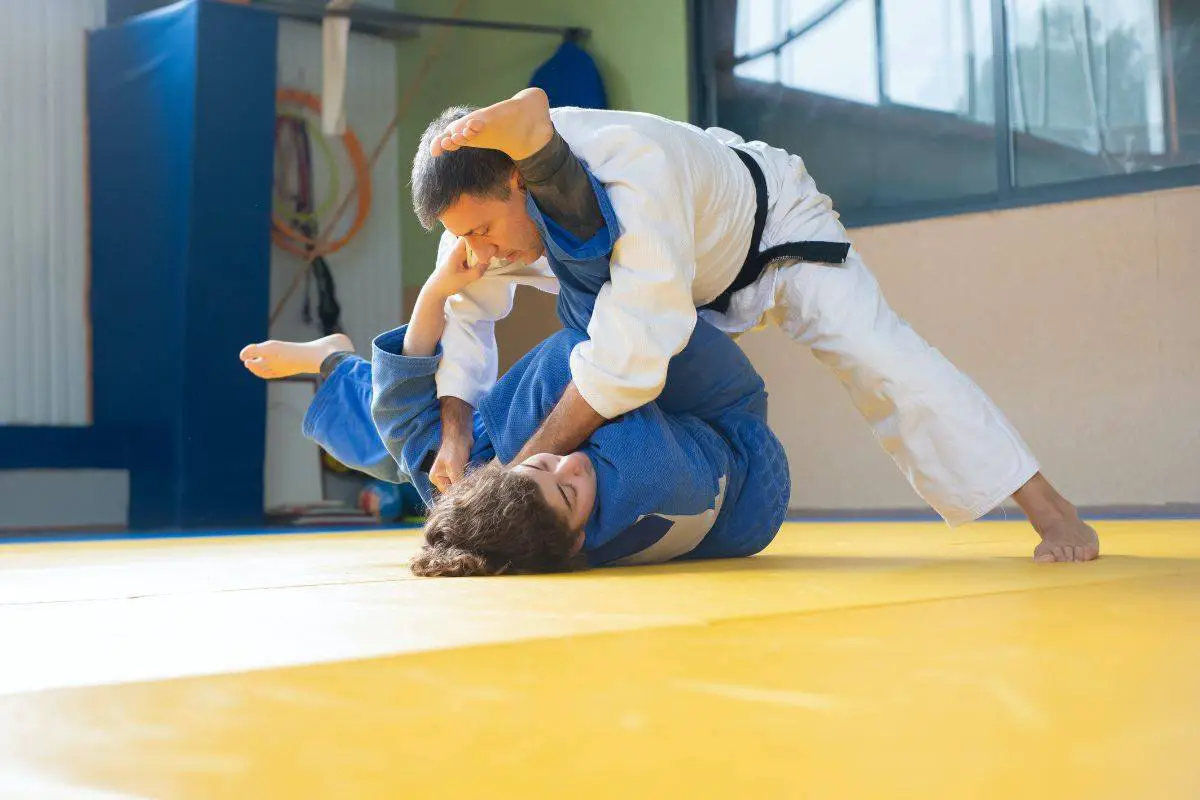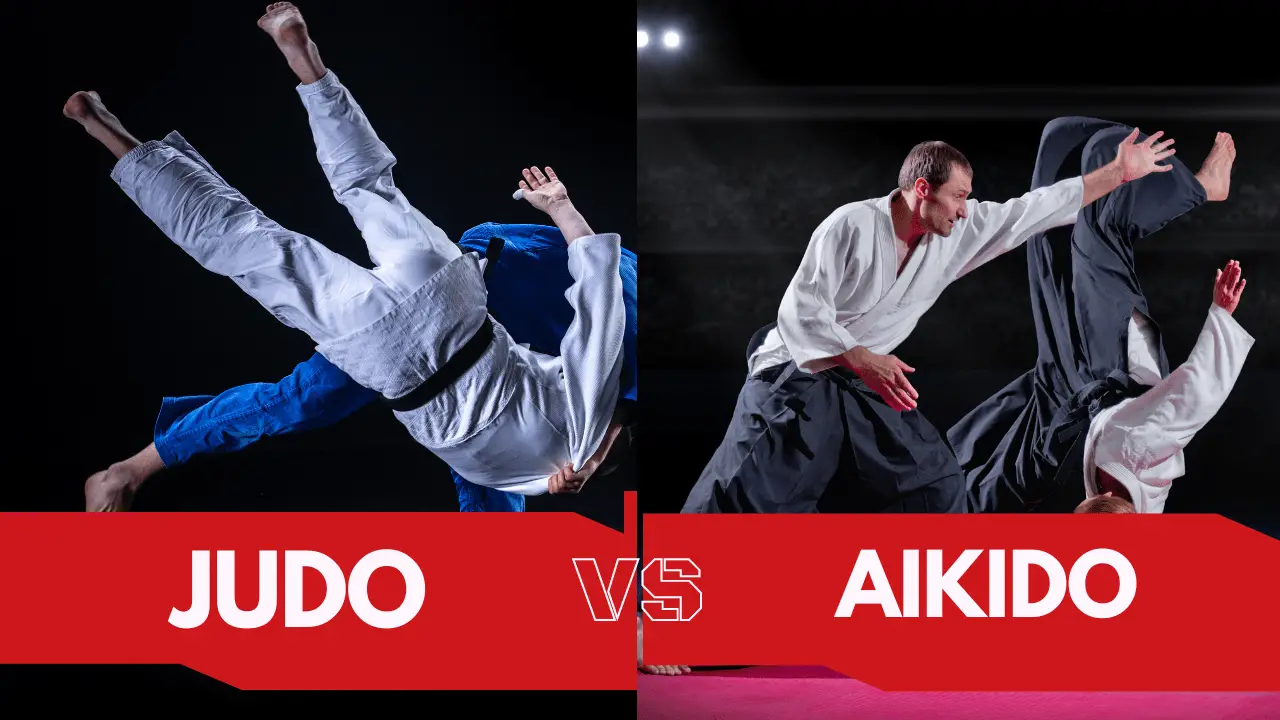Judo and Aikido are two highly effective martial arts, both for self-defense and self-development. Therefore, it might be difficult to understand the differences and similarities between them, which is the key to knowing which is the better one.
It is even more difficult to choose between the two. So if you’re reading this article in hopes to find an answer as to which one to learn, this article is for you. Furthermore, if you’re just reading this article for the sake of it, you’ll also benefit from reading it, trust me.
Once you finish reading, you’ll be more motivated than ever to start your training; trust me when I say that because I specifically emphasize taking action, which is what Blinklift is all about. We all know that real action is irreplaceable, which is why we must get on the mat and sweat.
Without real sweat, we won’t be able to see any results.
Anyways, let’s put Aikido and Judo in the spotlight and begin dissecting each one. We’ll then continue by comparing the two to see which one is better. Eventually, you’ll have an answer as to which one you’ll be better off learning.
So let’s dive in!
What Is Judo?
Let’s first examine the art of throwing grappling, Judo. We all know it because it’s an Olympic sport. Like it or not, it has some real applications to real life, making it one of the deadliest martial arts in the entire world.
Its history dates back to ancient Japan, where people needed to learn self-defense. Grappling was one of the most effective ways people used martial arts, which is the primary reason for the rising popularity of this fighting style. It actually derives from the ancient Jujitsu, which is a close-quarters martial art.
In the 19th century, modern Judo was constructed. It included various grappling moves, including joint locks, submissions, chokes, takedowns, and throws.
Today, it’s an Olympic sport and a widely practiced martial art. I find it impossible for it to have as many trainees as it has today and be ineffective. It has to bring real value to the trainees for it to retain such a level of success, which is one of the reasons I believe popularity is indirectly linked to effectiveness and the value of a martial art!
What Is Aikido?
Now that we’re familiar with what Judo is and why it’s as effective and popular as it is, let’s examine the second martial art we’ll dissect in this article, Aikido.
Aikido is a martial art that’s all about being one with your enemy. That’s definitely weird to say, but hear me out. Once you understand to manipulate the opponent’s movements, momentum, and energy to your advantage, you’ll be in complete control of the fight.
Your opponent charges into you? Fantastic. A great option you have is to lock him in place in order to control him, which you can do by using Aikido.
You’ll also learn to use weapons, grappling, and striking techniques, also known as Atemi. Eventually, you’ll learn to fight while developing yourself as a person and learning to observe your opponents before making a move, allowing you to become a better fighter in ALL martial arts.
Differences Between Aikido and Judo
Now that we understand what these martial arts look and act like, we can begin to compare them to understand which is better for which scenario.
Assuming your sole goal is to learn to fight, there’s a clear winner for that purpose, which we’ll cover in the upcoming sections. Therefore, you’ll find it harder to stay consistent if you pick the other one.
This is, perhaps, the most important part of this article. Understanding how Aikido and Judo differ—is key to choosing one to learn and being confident in this decision.
Without further intro, let’s dive in!

#1 – Fighting techniques
The first and most important difference is what you’ll learn. If there’s anything that needs to drive your decision-making process, it’s this one. If you don’t know what each teaches and why it’s different, you won’t be able to really understand which one you want to learn.
Aikido is the art of harmony, which means you’ll use the opponent’s momentum to defend yourself and step out of the fight unharmed. You’ll learn takedowns, grappling, joint locks, and hitting pressure points for maximum self-defense coverage.
On the other hand, Judo is the art of throwing grappling. However, many traditional martial arts schools combine Judo with its origin, Jujitsu—to create a more complete and versatile fighting style.
For the sake of clarity, we’ll focus on modern Judo, which is entirely about throwing grappling. So you’ll learn takedowns, throws, submissions, chokes, and joint locks.
In Judo, you’ll understand how to use the opponent’s strength against him, which is fantastic if you face someone stronger than you.
So this is the first, and most important, difference between these two martial arts. Think with yourself which of these would you want to learn, and here’s your answer.
However, let’s continue comparing the two so you can come to a better conclusion!
#2 – Fighting approach
The next difference we’ll review is each martial art’s fighting approach. How each fighting style treats fighting—is critical to understanding which is more suitable to your preferences.
Aikido is more about harmony and not being on the offensive. Indeed, it emphasizes a defensive fighting approach. That means that you won’t rush into your opponent if he doesn’t do so first.
Judo, however, is a much more offensive martial art. You’ll learn to use your opponent’s body against him, making it much easier to face bigger opponents than yourself. It emphasizes being on the offensive to avoid being on the defensive.
You’re probably familiar with the quote: “offense is the best defense.” Indeed, that’s the approach Judo has taken on itself. Why be on the defensive side when you can come off strong, especially in street fights and self-defense situations?
#3 – Pressure testing and competitions
The next difference we’ll review is pressure testing and competition. This is one of the primary differences and one that might give you the answer as to which one you want to learn.
First, let’s review Judo since you probably know the answer to that already. The art of throwing grappling utilizes various pressure testing and sparring situations. In them, you’ll learn and progress the most because you’ll put your skills to the test.
This is why pressure testing is a critical component of martial arts. How can you know you’re a competent fighter when you have never really fought someone in an all-in fight? This is why sparring and pressure testing, which Judo utilizes, are crucial to your progression and fighting journey.
On the other hand, Aikido is known for not utilizing pressure testing and sparring. I once heard an Aikido master explaining why that’s the case, here’s his explanation: “Aikido is one of the deadliest martial arts, which if you were to apply against your training partner, you might end up permanently injuring them, so we avoid pressure testing as a whole.”
You might like the idea of not sparring or competing, which is totally fine. And the reason for that seems valid if you ask me. But again, there’s no replacement for putting everything on the line and seeing if you actually know how to fight, against someone who pressures you exactly like in a real fight.
#4 – Mindset
And now, let’s examine the last difference of this article, the mindset difference between these two fighting styles. And don’t worry, I’ll be as concise as possible with this one.
I find it interesting to see most martial art emphasizing keeping everyone unharmed, including an attacker. If someone rushes into you and starts attacking you, our natural instincts tell us that it’s fine if we hurt him, because he deserves it.
However, that’s not the mindset Aikido adopted throughout the years. Instead, it adopted a mindset of hurting someone means hurting oneself. Hence, one of your goals is to keep everyone injury-free, including your opponents.
Judo, however, utilizes various techniques that allow you to disable an opponent quickly. But that’s not all. It also teaches you to react to people who attack you and cause damage to them, which is what martial arts are about.
So the mindset difference between the two—is vast. Again, it all comes down to whether they’re defensive or offensive.
Similarities Between Aikido and Judo
Now that you know how Aikido and Judo differ, it’s time we move on to something not less important, how they’re similar.
You might hesitate to choose between the two, which is valid. However, you want to understand a key point, these martial arts are more similar than you think. Perhaps you’d be better off choosing one or the other, but you’ll be experiencing the same hardships and challenges along the way, which also means you’ll experience the same benefits.
So now, I want to dive into the resemblances between Judo and Aikido, so you can begin to understand that it doesn’t really matter which one you’ll choose, as you’ll gain the same benefits in both.
Let’s dive into the first similarity.
#1 – Origin
The first one we’ll review is the origin. At the end of the day, both martial arts originated in Japan. Not only that, but they also come from the same martial art, Jujitsu (which comes up in one of the upcoming similarities.)
The fact that they’re both from Japan means a lot. They’re more similar than the naked eye can see. Only martial arts fanatics and masters will understand that these fighting styles resemble each other in endless ways, especially in the grappling sphere.
If you want to learn more about the best Japanese martial arts, follow this link!
#2 – Training with partners
The second way they resemble each other is in the fact that they both utilize training with other people. This might be obvious, but various martial arts, such as some Kung Fu styles, don’t require you to train with a partner.
Judo and Aikido, on the other hand, utilize people to force you to progress and put you in uncomfortable situations. There isn’t a better way to progress than to train with someone else!
#3 – Personal development
The next similar trait we’ll review is the fact that both Aikido and Judo’s primary result is self-improvement in all realms of life.
Did you know that training in martial arts allows you to increase your confidence and self-esteem? Indeed, by consistently practicing martial arts, you’ll be able to believe in yourself and control your mind to a better degree.
These benefits are uncanny. They’re irreplaceable in today’s world. However, they seem to have gone scarce to the point where you might not spot a truly confident person for a few days at a time.
If developing yourself is one of your goals, rest assured; you’ll be able to achieve that regardless if you choose Judo or Aikido!
#4 – Techniques derived from Jujitsu
Both arts incorporate techniques derived from jujitsu, an ancient Japanese martial art that focuses on close combat and grappling. Throws, joint locks, and pins are common elements found in both Judo and Aikido.
And again, this goes back to the point where these fighting styles resemble each other in many ways, usually ways that you won’t be able to immediately spot.
They both come from the same martial art, Jujitsu. Isn’t that enough to convince you that it doesn’t really matter which one you’ll choose?
Judo vs. Aikido for Self-Defense
It’s worth discussing self-defense alone because it’s a question I get all the time. Honestly, it might be the most important factor for most people reading this article. So which martial art is better for that purpose?
Judo is more effective in self-defense than Aikido because it teaches us to be aggressive and offensive rather than defensive, which is the most important factor for self-defense. If someone attacks you and you need to defend yourself, you don’t want to focus on ensuring he steps out of the fight unharmed, as Aikido teaches.

Which Is Easier to Learn, Aikido or Judo?
Aikido is easier to learn compared to Judo because it doesn’t incorporate any pressure testing and is less physical, making it more manageable to learn. Of course, it still will be more than difficult to retain consistency in both fighting styles. However, Judo will be more physically demanding, especially in the beginning.
Should I Learn Judo or Aikido?
If you’re interested in learning self-defense, Judo is for you. However, if you desire to study a valuable martial art that’s all about harmony and using your opponent’s movements against him by using grappling and striking techniques, go with Aikido. In both instances, you’ll greatly benefit yourself.
Final Words
The next step for you is to get on the mat and start practicing either one. If you have read this article in hopes to find an answer to which is the better martial art for you, I’m sure you’ve found it.
Now, however, it’s time for you to take action, which I know is difficult. Although it might be costly and you’ll prefer to stay in your comfort zone, there’s no better way to kick off your self-improvement and fighting journey other than signing up at a local martial arts gym and getting reps in.
Real mat experience is irreplaceable in martial arts. Good luck!
Here are other articles you’d enjoy reading:
Aikido vs. MMA – The Ultimate Showdown!
Is Aikido Effective? For Self-Defense and Street Fights
Should You Learn Aikido? The Truth
7 Tips to Perfect Your Takedowns (For BJJ & Judo)
Foot Sweep Guide (For BJJ, Judo, and Wrestling)
Do BJJ and Judo Complete Each Other? Full Guide
Karate vs. Judo – Which Is the Better Martial Art?
Is Aikido a Grappling or Striking-Based Martial Art?

